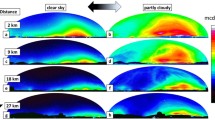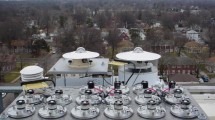Abstract
Among the different available technologies to estimate and forecast solar irradiance, total sky imagers are a suitable option for short-term horizons (less than 30 min). For this purpose, cameras are able to capture images at high speed (less than a second), depending on hardware and configuration, while solarimetric measurements are restricted to the characteristic response time of pyranometers, that varies from 15–60 s, depending on its quality. This difference in sampling time may lead to asynchronous data logging. As a result, two data sets with different sampling time are obtained. A close look into specialized literature showed a lack of evidence on data synchronization of reported results. Thus, the existence of asynchronous data is a plausible assumption. The main objective of this study is to investigate the effect of considering two different approaches in which data can be treated for the estimation of the solar irradiance and clearness index. For this purpose, two data sets are available: solar irradiance with a sampling time of 1 min, and sky images taken at 5 s intervals. Image acquisition system is based on a fisheye camera and a cost-effective and portable device. In one approach solar irradiance is interpolated to image time, and in the second approach, extracted image data is interpolated to solar irradiance time. For each case, solar irradiance and clearness index estimation is based on a multiple linear regression with two different number of features extracted from sky image processing. To evaluate these models, the mean bias error, root mean square error and the mean absolute percentage error were used. Obtained results shows that using different approaches to process data of measurements may lead to errors of 6.2% for the solar irradiance and 3% for the clearness index.





Similar content being viewed by others
REFERENCES
Miloudi, L., Acheli, D., and Kesraoui, M., Application of artificial neural networks for forecasting photovoltaic system parameters, Appl. Sol. Energy, 2017, vol. 53, no. 2, pp. 85–91.
Namrata, K., Sharma, S.P., and Seksena, S.B.L., Empirical models for the estimation of global solar radiation with sunshine hours on horizontal surface for Jharkhand (India), Appl. Sol. Energy, 2016, vol. 52, no. 3, pp. 164–172.
Chabane, F., Guellai, F., Michraoui, M.Y., Bensahal, D., Bima, A., and Moummi, N., Prediction of the global solar radiation on inclined area, Appl. Sol. Energy, 2019, vol. 55, no. 1, pp. 41–47.
Kurtz, B. and Kleissl, J., Measuring diffuse, direct, and global irradiance using a sky imager, Sol. Energy, 2017, vol. 141, pp. 311–322.
Rocco, J.D., Bourke, P.D., Patterson, C.B., and Kider, J.T., Real-time spectral radiance estimation of hemispherical clear skies with machine learned regression models, Sol. Energy, 2020, vol. 204, pp. 48–63.
Alonso-Montesinos, J., Batlles, F.J., and Portillo, C., Solar irradiance forecasting at one-minute intervals for different sky conditions using sky camera images, Energy Convers. Manage., 2015, vol. 105, pp. 1166–1177.
Alonso-Montesinos, J., Real time automatic cloud detection using a low-cost sky camera, Remote Sens., 2020, vol. 12, p. 1382.
Satilmis, P., Bashford-Rogers, T., Chalmers, A., and Debattista, K., Per-pixel classification of clouds from whole sky HDR images, Signal Process. Image Commun., 2020, vol. 88, id. 115950.
Schmidt, T., Kalisch, J., Lorenz, E., and Heinemann, D., Evaluating the spatio-temporal performance of sky-imager-based solar irradiance analysis and forecasts, Atmos. Chem. Phys., 2016, vol. 16, pp. 3399–3412.
Valentin, L., Peña-Cruz, M., Moctezuma, D., Peña-Martinez, C.M., Pineda-Arellano, C.A., and Díaz-Ponce, A., Towards the development of a low-cost irradiance nowcasting sky imager, Appl. Sci., 2019, vol. 9, id. 1131.
Peng, Z., Yoo, S., Yu, D., and Huang, D., Solar irradiance forecast system based on geostationary satellite, in 2013 IEEE Int. Conf. Smart Grid Communications, 2013, pp. 708–713.
Dev, S., Wen, B., Lee, Y.H., and Winkler, S., Ground-based image analysis: A tutorial on machine-learning techniques and applications, IEEE Geosci. Remote Sens. Mag., 2016, vol. 4, no. 2, pp. 79–93.
Dissawa, D.M.L.H., Godaliyadda, G.M.R.I., Ekanayake, M.P.B., Ekanayake, J.B., and Agalgaonkar, A.P., Cross-correlation based cloud motion estimation for short-term solar irradiation predictions, in 2017 IEEE Int. Conf. on Industrial and Information Systems (ICIIS), 2017, pp. 1–6.
Jiang, H., Gu, Y., Xie, Y., Yang, R., and Zhang, Y., Solar irradiance capturing in cloudy sky days – A convolutional neural network based image regression approach, IEEE Access, 2020, vol. 8, pp. 22 235–22 248.
Mondragón, R., Alonso-Montesinos, J., Riveros-Rosas, D., and Bonifaz, R., Determination of cloud motion applying the Lucas-Kanade method to sky cam imagery, Remote Sens., 2020, vol. 12, id. 2643.
Chao Wang, G., Urquhart, B., and Kleissl, J., Cloud base height estimates from sky imagery and a network of pyranometers, Sol. Energy, 2019, vol. 184, pp. 594–609.
Zaher, A., Thil, S., Nou., J., Traoré, A., and Grieu, S., Comparative study of algorithms for cloud motion estimation using sky-imaging data, IFAC-PapersOnLine, 2017, vol. 50, no. 1, pp. 5934–5939.
Chow, C.W., et al., Intra-hour forecasting with a total sky imager at the UC San Diego solar energy testbed, Sol. Energy, 2011, vol. 85, no. 11, pp. 2881–2893.
Urquhart, B., Kurtz, B., Dahlin, E., Ghonima, M., Shields, J.E., and Kleissl, J., Development of a sky imaging system for short-term solar power forecasting, Atmos. Meas. Tech., 2015, vol. 8, no. 2, pp. 875–890.
Calbó, J. and Sabburg, J., Feature extraction from whole-sky ground-based images for cloud-type recognition, J. Atmos. Oceanic Technol., 2008, vol. 25, no. 1, pp. 3–14.
Yuan, Y., Minjing, M., and Menglu, Z., Cloud detection method based on feature extraction in remote sensing images, in International Archives of the Photogrammetry, Remote Sensing and Spatial Information Sciences, 2013, vol. XL–2/W1, pp. 173–177.
Zhang, J., et al., A suite of metrics for assessing the performance of solar power forecasting, Sol. Energy, 2015, vol. 111, pp. 157–175.
Alonso, J. and Batlles, F.J., Short and medium-term cloudiness forecasting using remote sensing techniques and sky camera imagery, Energy, 2014, vol. 73, pp. 890–897.
Yang, H., et al., Solar irradiance forecasting using a ground-based sky imager developed at UC San Diego, Sol. Energy, 2014, vol. 103, pp. 502–524.
West, S.R., Rowe, D., Sayeef, S., and Berry, A., Short-term irradiance forecasting using skycams: Motivation and development, Sol. Energy, 2014, vol. 110, pp. 188–207.
Nouri, B., et al., Cloud height and tracking accuracy of three all sky imager systems for individual clouds, Sol. Energy, 2019, vol. 177, pp. 213–228.
Fu, C. and Cheng, H., Predicting solar irradiance with all-sky image features via regression, Sol. Energy, 2013, vol. 97, pp. 537–550.
Herrera-Carrillo, N.E., Rivero, M., Gómez-Ramirez, E., and Loera-Palomo, R., Solar irradiance estimation based on image analysis, in 2018 IEEE International Autumn Meeting on Power, Electronics and Computing (ROPEC), 2018, pp. 1–6.
Bone, V., Pidgeon, J., Kearney, M., and Veeraragavan, A., Intra-hour direct normal irradiance forecasting through adaptive clear-sky modelling and cloud tracking, Sol. Energy, 2018, vol. 159, pp. 852–867.
Wang, F., et al., Image phase shift invariance based cloud motion displacement vector calculation method for ultra-short-term solar PV power forecasting, Energy Convers. Manage., 2018, vol. 157, pp. 123–135.
Kamadinata, J.O., Ken, T.L., and Suwa, T., Sky image-based solar irradiance prediction methodologies using artificial neural networks, Renewable Energy, 2019, vol. 134, pp. 837–845.
Peng, Z., Yu, D., Huang, D., Heiser, J., and Kalb, P., A hybrid approach to estimate the complex motions of clouds in sky images, Sol. Energy, 2016, vol. 138, pp. 10–25.
Chu, Y., Li., M., and Coimbra, C.F.M., Sun-tracking imaging system for intra-hour DNI forecasts, Renewable Energy, 2016, vol. 96, pp. 792–799.
Heinle, A., Macke, A., and Srivastav, A., Automatic cloud classification of whole sky images, Atmos. Meas. Tech., 2010, vol. 3, no. 3, pp. 557–567.
Du, J., Min, Q., Zhang, P., Guo, J., Yang, J., and Yin, B., Short-term solar irradiance forecasts using sky images and radiative transfer model, Energies, 2018, vol. 11, no. 5, id. 1107.
Zhang, Y., Wang, S., and Ji, G., A comprehensive survey on particle swarm optimization algorithm and its applications, Math. Probl. Eng., 2015, vol. 2015, pp. 1–38.
Marquez, R. and Coimbra, C.F.M., Intra-hour DNI forecasting based on cloud tracking image analysis, Sol. Energy, 2013, vol. 91, pp. 327–336.
Funding
N. Herrera thanks the grant from CONACyT. M. Rivero and R. Loera acknowledge to CONACYT for the support provided through program “Cátedras CONACyT.”
Author information
Authors and Affiliations
Corresponding author
About this article
Cite this article
Herrera, N., Orozco, S., Rivero, M. et al. Effect of Asynchronous Data Processing on Solar Irradiance and Clearness Index Estimation by Sky Imagery. Appl. Sol. Energy 56, 508–516 (2020). https://doi.org/10.3103/S0003701X20060043
Received:
Revised:
Accepted:
Published:
Issue Date:
DOI: https://doi.org/10.3103/S0003701X20060043




